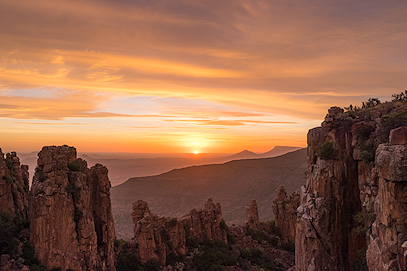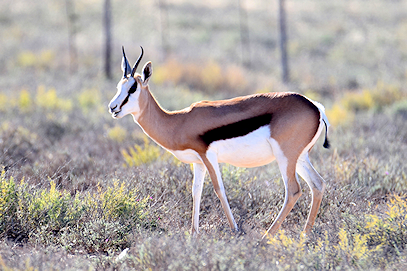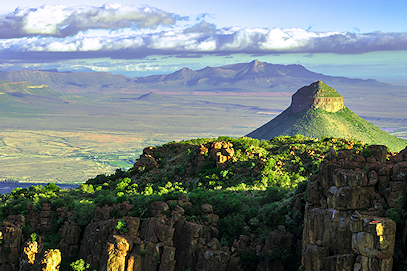South Africa's Camdeboo National Park
Help Me Plan- Home
- >
- African Travel
- >
- South Africa
- >
- National Parks
- >
- Camdeboo National Park
Camdeboo National Park Destination Guide
Camdeboo National Park covers 19,405 hectares around Graaff-Reinet in the Karoo. Famous for the dramatic Valley of Desolation with towering dolerite pillars, it offers unique geological formations, Nqweba Dam, and diverse wildlife. This remote reserve provides a peaceful escape with scenic drives, hiking trails, and stunning desert landscapes ideal for slow travel and photography.
Getting There
By Air: George and Chief Dawid Stuurman International Airport in Gqeberha (formerly Port Elizabeth) are easily accessible from major hubs, with daily flights between them. The preferred final flight destination is Gqeberha because it is closest to the park.
By Road: It is approximately 353 km from George Airport and 250 km from Gqeberha. Visitors are transported via private, air-conditioned vehicles from one of the above airports, depending on their package.
Weather & Best Time To Visit
The park lies in the eastern Great Karoo, which receives most rainfall in spring and summer, often with thunderstorms and high temperatures. Winters are cold; snow can sometimes be seen higher in the mountains.
It is best to visit in spring or early summer, from August to November, when wildflowers bloom and newborn antelope are visible on the shrubland. Plan strenuous activities for early morning or late afternoon during hot spells.

Camdeboo National Park offers walking trails from easy one-hour routes to extended hikes with overnight camping. Forty-three mammal species occur in the park. Visitor can see steenbok, black wildebeest, and blesbok in the open areas, while kudu and grey duiker favor thickets. Cape buffalo and mountain zebra are occasional, and red hartebeest and gemsbok are commonly sighted.
Reasons to visit Camdeboo National Park
Natural Monuments
Nature is the ultimate builder, sculptor, and artist. The dolerite pillars that reach heights of roughly 90 to 120 meters in the Valley of Desolation leave visitors feeling overwhelmed and humbled.
Sheer Wonder
The Valley of Desolation showcases volcanic and erosional forces over millions of years. Sheer cliffs and balanced columns are revealed from scenic routes and picnic sites throughout the park.
Anomalous Abundance
At the foot of the Sneeuberg Mountains, the plains and Nqweba Dam support animal, bird, reptile, and fish diversity, with seasonal wildflower color adding contrast to the Karoo expanse.
Experiences to Savor at Camdeboo National Park
Savor the silence and solitude and watch for wildlife you may usually overlook in more game-viewing-oriented parks.

The silent places
There is something remarkable about standing quietly on the precipices around the Valley of Desolation. The silence that embraces the rock faces tells a story of power and time, and when compared to human scale, the experience feels otherworldly.
Bucks to birds
You can see springbok moving across the plains and ostrich striding through open country. The contrast of antelope on red earth with big skies makes simple sightings memorable.
Picture perfect
The setting is made for photography: ancient geology under mountains beside a dam and a river, surrounding one of South Africa’s oldest towns. Dawn light rewards early risers.Useful Information
History
Graaff-Reinet is the fourth-oldest town in South Africa. Founded in 1786 on the banks of the Sundays River, its cultural and historical attractions draw visitors year-round. The Camdeboo National Park, previously the Karoo Nature Reserve, surrounds the town. The Karoo Nature Reserve was established in 1979 to conserve the Karoo biome and was proclaimed as Camdeboo National Park in 2005.
The area’s history stretches millennia. It is geologically and archaeologically rich, from dolerite pillars to prehistoric fossils. Evidence of Stone Age dwellers appears along the Sundays River to the Eastern Cape coast. Nomadic people created rock paintings, shelters, and tools for hunting, fishing, and wild food harvests.
Wildlife
Animal groups here are well adapted to semi-arid conditions. The 43 mammal species include antelope like springbok and kudu, lesser mammals like vervet monkey and meerkat, and carnivores like bat-eared fox. Amphibians and reptiles are also present, though reptile prefer shade during the heat of day.
Roughly 250 bird species have been documented, including ostrich, stork, rock kestrel, Diederik cuckoo, brown-hooded kingfisher, Namaqua dove, cardinal woodpecker, speckled mousebird, long-billed crombec, and ant-eating chat. Various hawk and eagle are recorded, and water birds like flamingo occur in spring and summer. The Nqweba Dam holds fish and attracts bird and birders.
Vegetation & Terrain
The Karoo is very dry, but classified as semi-desert due to annual precipitation. Plant types vary by season and altitude. Shrubland dominates higher slopes, with grassland in valleys. Succulent thicket, including aloe, is another key type.
Over hundreds of millions of years, volcanic and erosive processes shaped the park’s geology. The Valley of Desolation’s dolerite pillars and sheer cliffs are signature features, with oddly sculpted mountains such as Spandaukop forming the Karoo silhouette.
Activities
The park’s diverse landscape offers wide-ranging activities. A drive or hike to the Valley of Desolation delivers sweeping views. Day and overnight hiking trails offer excellent wildlife viewing and scenery.
Bird watching is outstanding, especially at Nqweba Dam. The dam also suits fishing, boating, canoeing, and, weather permitting, windsurfing. Two 4x4 trails of varying difficulty traverse the park.









